ASUS Zenbook Prime (UX21A) Review: The First of the 2nd Gen Ultrabooks
by Anand Lal Shimpi on May 22, 2012 2:46 PM EST- Posted in
- Laptops
- CPUs
- Asus
- Ivy Bridge
- Zenbook
- Zenbook Prime
- Ultrabook
- Notebooks
The Zenbook Prime Exterior
The all-aluminum Zenbook chassis makes another appearance with the Zenbook Prime. It's the same thickness and weight as its predecessor. The Prime also features the same port configuration. On the 11-inch model you get two USB 3.0 ports (one on each side), a mini VGA out (with bundled dongle), micro HDMI out and shared audio/mic jack. The 13-inch model adds an SD card reader, while the thicker UX32 adds full sized HDMI and a third USB 3.0 port on top of that.
While the outside of the Zenbook hasn't changed at all, it's what's inside that's completely different. Both the UX21 and UX31 now feature 1920 x 1080 IPS panels. I'll get into the debate over the usability of such a high res on such an 11.6 inch display shortly, but at a high level this is just awesome. ASUS is finally putting the type of attention we've been asking for on display technology. The 1080p panel on the UX21 looks amazing and performs extremely well as you'll soon see. I can only assume the UX31's panel is similarly impressive.
What else got updates? The camera (now 720p), keyboard, trackpad, WiFi, USB 3.0 and power adapter, to name a few.
The New Keyboard
The keyboard is all-new on the Zenbook Prime. Although it doesn't look as stylish as what ASUS introduced in the original, the new keyboard is worlds better to type on. It feels almost identical (but not completely) to the MacBook Air keyboard, which in my opinion is a good thing. Finger fatigue is significantly reduced compared to the original Zenbook. ASUS claims 12% increased key travel compared to the predecessor which definitely contributes to a better typing feel.
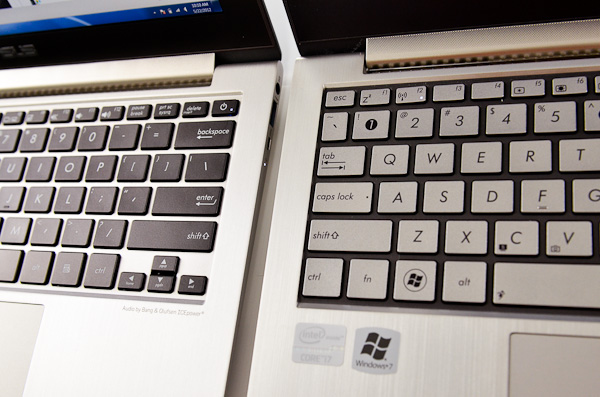
The new keyboard (left) vs. the old keyboard (right)
The keyboard obviously looks very similar to Apple's chiclet as well and now features a LED backlight. There are three selectable brightness settings for the keyboard backlight (four if you count off), which you control via a keyboard shortcut (fn F3/F4).
A Much Improved Trackpad
The problematic trackpad from the original Zenbook was actually addressed mid-cycle last generation. ASUS switched to an ELAN trackpad that did away with most of the issues I encountered. Users who wanted the new trackpad could call, complain and should've been able to get their unit swapped out although there was never a formal replacement program. The Zenbook Prime uses the same trackpad, although this is my first personal experience with it in a Zenbook.
In short, it's much better than what I originally reviewed. Keeping one finger on the trackpad's left click area while you move the pointer is no longer an issue. The pointer will occasionally refuse to move but it's very rare and ASUS even ships software that lets you tweak the trackpad's sensor to better match how you use it:
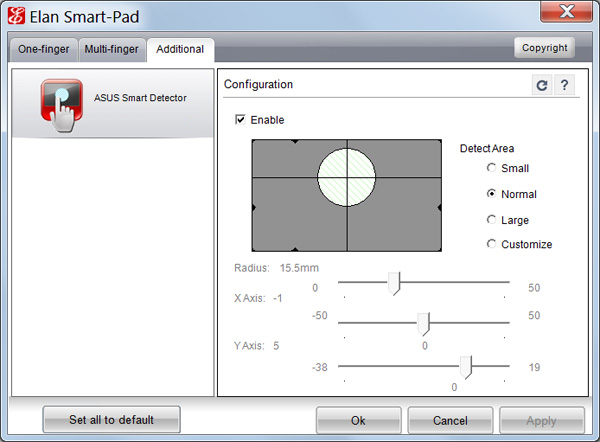
Tap to click and actually clicking the trackpad are both non-issues again. Two finger scrolling as well as three finger forward/back gestures all work very well. Overall the experience is pretty good, albeit not quite perfect. It's likely the best ASUS can do without writing its own trackpad driver. At some point it may just come to that however.
An Updated Power Adapter
The 45W power adapter from the Zenbook gets a slight update as well. Remember the charge indicator that never turned off? Fixed. Also the somewhat worrisome power connector has been beefed up, it's a bit thicker and I'm less worried about it snapping off.
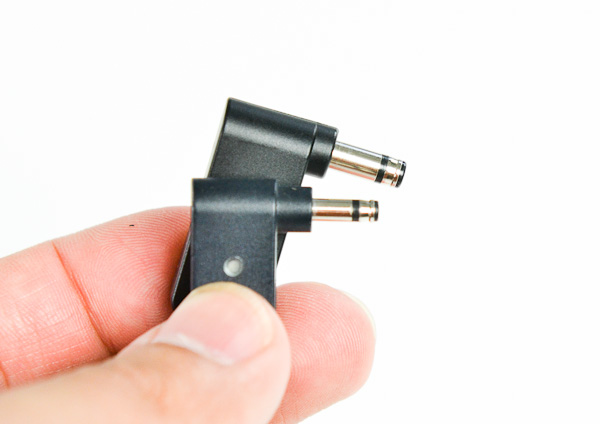
The old Zenbook power connector (bottom) vs. the new Zenbook Prime connector (top)
I shouldn't be surprised that ASUS fixed these things but it's just so rare that a company listens to feedback and acts appropriately in such a short period of time. I would still like to see a MagSafe clone and better cable management than a bit of velcro, although navigating around any associated patents there should be fun for ASUS' lawyers.
Vastly Improved WiFi
The original Zenbook featured a 2.4GHz Qualcomm Atheros AR9485 802.11b/g/n WiFi solution. Only supporting a single spatial stream the best sustained speeds I saw were around 5MB/s using 20MHz channels at 2.4GHz. The Zenbook Prime offers a considerable upgrade.

Now inside the machine is Intel's Centrino Advanced-N 6205 controller. The 802.11a/g/n controller adds 5GHz support and link speeds of up to 300Mbps. In practice I saw a doubling of performance under the same conditions as the original Zenbook (80Mbps vs. ~40Mbps).
As a side benefit, since ASUS is using Intel's Centrino WiFi on an Intel platform it also by default supports Intel's Wireless Display (WiDi) technology.
Just like last time, the UX21A comes with a sleeve case, VGA dongle and USB to 10/100 Ethernet adapter.
USB 3.0 on Both Ports
Courtesy of Intel's HM76 chipset found on the Zenbook Prime's motherboard are the notebook's two USB 3.0 ports. The original Zenbook had a single USB 3.0 port and one USB 2.0 port by comparison. USB 3.0 performance is a bit higher than what I measured with the original Zenbook. I had no problems sustaining transfers at above 170MB/s.
VGA and HDMI out are also supported. There's no Thunderbolt or DisplayPort on the Zenbook Prime unfortunately.
Simplified SSDs
The original Zenbook offered one of two SSDs depending on the model you picked up: Sandisk's U100 or ADATA's SandForce SF-2281 based XM11. If you'll remember back to my review of the original Zenbook I expressed concern that ASUS was shipping a known buggy firmware with the ADATA drive, although admittedly I didn't run into any of the SandForce BSOD issues during my review of the system. It looks like those concerns can be put to rest as ASUS has dropped SandForce from the Zenbook Prime. Sandisk's U100 is all that's available now.
As we've alluded to in the past, the U100 isn't the fastest SSD on the block but it should be very well priced for ASUS and obviously faster than a mechanical drive. Read speeds are quite good, but write performance is where the U100 falls short. Do a lot of IO (e.g. install a game or just write sequentially to the drive) and you'll notice IO latencies increase. It's the same issue we ran into early on in the MLC client SSD space, but no where near as bad. The good news is there's no stuttering or other similarly undesirable behavior. The system still functions like it has an SSD, it's just that it could be a lot faster under load. I'm saving a full investigation into U100 performance for final Zenbook Prime hardware.
My hope is that we'll see vendors offer drop in replacements for the drive similar to what we saw OWC do for the MacBook Air. I still haven't gotten a straight answer as to whether or not the ASUS drive is electrically compatible with the MacBook Air SSD, nor have I been brave enough to risk nuking a drive to find out. Update: the two SSDs are physically similar, but not physically compatible. Here's a challenge to all SSD makers out there: build an upgrade kit for the Zenbook.


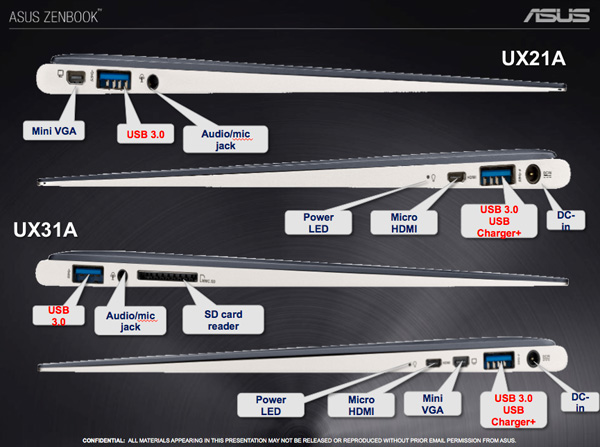
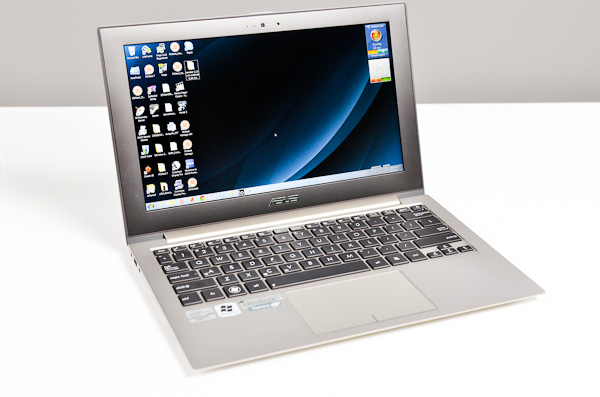






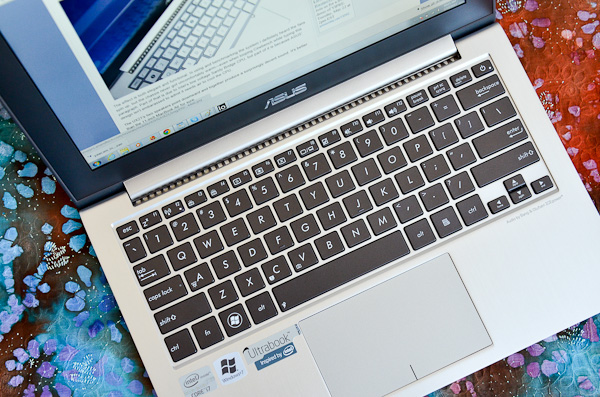
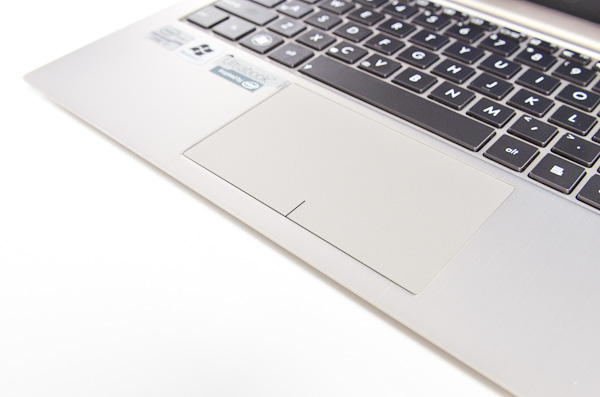
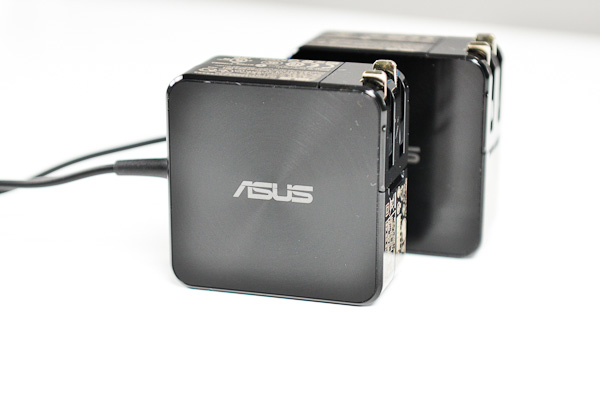
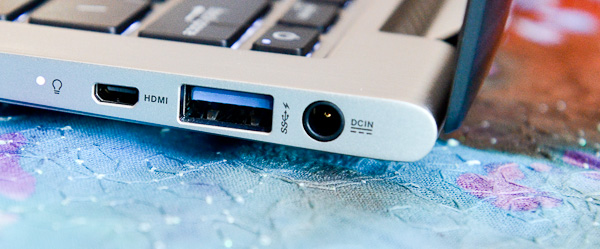








192 Comments
View All Comments
duploxxx - Wednesday, May 23, 2012 - link
quite a bold statement I would say without any proof on Haswell....At a high level, for any modern game, you shouldn't count on being able to run it at the Prime's native 1080p resolution. You need a discrete GPU (or Haswell) to pull that off.
Portal and total war really show what kind of GPU perf you can expect from the HD4000 still too low to run gaming decent just like the diablo3, wouldn't be my favorite "playable" fps
prdola0 - Wednesday, May 23, 2012 - link
I wish Asus added a Kepler-gen GeForce also into the 11" version. Then I'd buy it, but not like this.QQuxa - Wednesday, May 23, 2012 - link
less than 4 hours of internet browsing? :(icrf - Wednesday, May 23, 2012 - link
The UX31A-DB51 will be the perfect replacement for my dad, who's been using a netbook (Asus EEE PC 1000HA) as his primary computer for the last several years. The SSD speed doesn't concern me, but the DPI scaling does a bit, as small text is getting harder to read for his generation.aliasfox - Wednesday, May 23, 2012 - link
Nice machine. I recommended a UX31 to my dad a few weeks ago (needed something by end of May), with the caveat that if he was able to spend more money (business account), that getting the MBA had its advantages - better keyboard and screen, namely. It looks like the new generation does better on the screen and more or less matches the MBA on keyboard (I know Apple wasn't the first with chicklets, but the MBA and UX21A keyboards are so similar that I wouldn't be surprised if they were using the same OEM for the keyboard).My question though is why did ASUS wait until IVB to come out with the chassis (keyboard, screen) changes? If they had been ready near the beginning of the year (just an assumption), ASUS could have definitively trounced the competition, MBA included. Having a paper launch mere weeks ahead of the (expected) new MBA launch - and having a retail launch likely within the same week - gives everybody a lot of incentive to wait and see what the other guy is doing.
I haven't seen mini VGA since my PowerBook G4 from 2003. Wonder if I could sell my decade-old s-video and VGA adapters now!
But yes, TB would've been a much better option than multiple mini video ports...
KPOM - Wednesday, May 23, 2012 - link
It will be nice to see what Apple has in store for the next MacBook Air. The available 1920x1080 display in the 11.6" UX21 is a nice option. Hopefully Apple will see that and raise with a Retina Display (2732x1536), complete with Mountain Lion's new HiDPI.I wonder if Apple will wait for Mountain Lion to be ready before shipping the new Air and Pro (like they did last year with the Air), or if the flood of Ivy Bridge Ultrabooks will force their hand. Mac sales have been a little below estimates the last two quarters, so my guess is that they won't wait for the OS this time around.
hechacker1 - Thursday, May 24, 2012 - link
Pretty sure that Mountain Lion is right around the corner, other than HiDPI stuff, it isn't a huge change from Lion.And they'll absolutely need resolution doubling in place for it to be usable.
I too await to see their competition. Though the prime is already looking good.
ReverendDC - Wednesday, May 23, 2012 - link
This is....nice. I do see incremental improvements in the Ivy Bridge system vs Sandy Bridge. In the end, though it was ASUS that really made this system shine. A 1920x1080 in an 11"?! Whoa!Let's not gloss over the fact that ASUS heard their users' complaints and made the appropriate changes within 6 months. That is extremely rare for a modern PC company, whether MSFT or Apple-based. They really need to receive appropriate kudos for their recent operations. They have definitely become an option for me going forward just for that fact.
What we really need is competent competition. Hopefully, AMD delivers Trinity in a similar form factor for far cheaper than these options. Even the $799 system listed would go for about $499 - $599 with AMD silicon, but you won't get the raw computing power. At the same time, you would have a road warrior gaming system with "good enough" computing. I know this is a bucket I find myself in many times.
Still, nothing to shake a leg at, and great review, AnandTech. Things are improving on the Windows front in terms of design and use.
Sunburn74 - Wednesday, May 23, 2012 - link
There is a limit to how crappy a processor you can have in your laptop and get away with it, even with a SSD. My gf has my asus ul30vt whilst I am using an HP envy 14 (2010). Both have 120gb sandforce SSDs in them. The asus is noticeably more sluggish with everything. Virus scans take over an hour (on my hp envy its about 10 mins), pdfs are choppy, programs take time to load, etc.You can only lowball the processor so much.
Personally, if you're buying a laptop for use for 2-3 years, I'd pay the 200 dollar difference for the more serviceable processor over the long run. When talking about PCs, people talk about future proofing, and not necessarily lowballing your components. You'd think with the less tweakable laptops that concept would be even more prevalent.
IntelUser2000 - Friday, May 25, 2012 - link
It's unlikely you'll see $200 in savings just over the CPU since the top Core i7 is at $300. It would be possible over the Core i7, but its at $999. So you are looking at average of $50 savings for $749, or at most $100 at $699. Going lower AMD would be giving CPUs for free, or sacrificing other components.